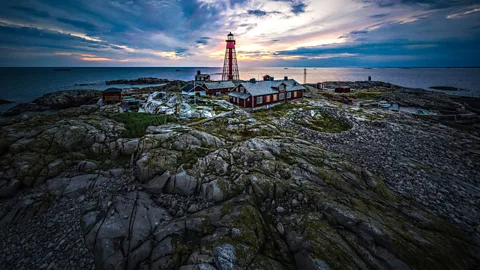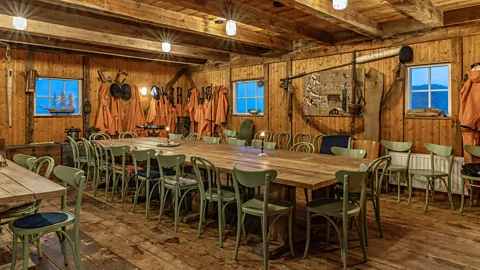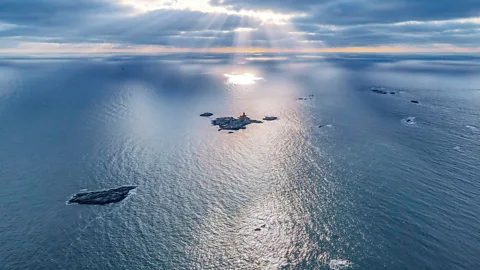Pater Noster: The luxury hotel on an isolated, inhospitable isle
 Erik Nissen Johansen
Erik Nissen JohansenOnce a place to warn sailors of perils off Sweden's west coast, Pater Noster now welcomes travellers looking for an alternative to modern life.
Waves turned our boat into a bucking bronco on the journey to Hamneskär, an island 8km off Sweden's west coast, an hour or so from Gothenburg. It was a neat reminder about the power of the sea and the reason for the island's tomato-red, 36m-tall Pater Noster lighthouse.
In the last 1,000 years, at least 700 ships are known to have sunk on these reefs; the lighthouse's name (Latin for "Our Father") comes from its position in a chain of islands that look like beads on a rosary, or, as some say, the prayer uttered by terrified sailors ing through these parts. From the top of the lighthouse, wrecks are still visible among the 200 islands, skerries and low-lying seal-slung rocks.
Safely in the harbour, I discovered a different scene entirely. The Pater Noster lighthouse, the centrepiece of an island measuring just 150m by 200m, is home to an award-winning, nine-room hotel retreat that honours its history while providing a luxurious escape from modern life.
"In 30 years' time, 95% of the world's population will live in big cities," said Erik Nissen Johansen, designer and founder of Gothenburg's internationally acclaimed hospitality design agency Stylt Trampoli, and one of the team behind the hotel. "If you want a vacation that makes sense, you need a contrast to your everyday life. Different is the currency."
 Erik Nissen Johansen
Erik Nissen JohansenThe hotel (total capacity 24 guests), a series of 19th-Century red-painted wooden buildings in the island's centre, certainly offers that. The three small houses were once home to lighthouse keepers and their families; there is also a boatshed, now a dining room and kitchen, and an old food storage vault with metres-thick walls that now functions beautifully as a wine cellar.
How to visit:
When to go: Peak travel season in the Gothenburg archipelago is June-July; for a quieter stay, go off peak.
How to get there: From Gothenburg, take a bus to Marstrand. The RIB to the island takes 15 minutes from Marstrand ferry port.
What to do: Relax, take in the sea air, take a tour of the island, swim, sauna and read. Previous guests have brought creative projects to complete in the quiet hut overlooking the old harbour. Fishing trips and kayak tours are also available.
What to eat: Pater Noster is a full-board hotel. Expect a superlative Swedish breakfast and a dinner of gourmet seaweed, lobsters and local fish.
Away from this mini hub, a sauna house gently simmers atop the rocks, two hot tubs stand on the cliff and a narrow path leads to a vegetable garden. Overlooking it all, the metal skeleton of the lighthouse looms large. It is still a beacon for the sailboats and tankers that skim the horizon but, decommissioned in 1977, it no longer serves an official function. That purpose is served by the modern lighthouse that's built into the seabed 3,500m away in the channel.
A stay here is something quite remarkable. It's a tiny island but it holds so much: my guided tour of the island – given to all guests – took me past the modern sauna and along the rocky coastline to the original flower and vegetable garden used by the first lighthouse keepers. It's all part of the experience here, which, at 15,000 SEK (£1,150) per night, is full board and all-inclusive of transport, activities and food.
Wine and oysters are enjoyed in the wine cellar, stories are told over a seaweed and seafood dinner, and much is focused on that blue space between the island and the horizon in order to educate guests about how to better treat the ocean.
It's a story that they walk as well as talk: furniture and decor was sourced second-hand in local spots to underline the cultural history story, and the hotel works with scientists to monitor lobster populations and tuna migrations.
 Erik Nissen Johansen
Erik Nissen JohansenTurning the historical cottages into a profitable hotel wasn't easy. The buildings had housed small-scale hotels before, but they hadn't proved sustainable, and the island had ed from hand to hand until Johansen saw the opportunity. Bringing together an eclectic group of ocean-loving partners, including a restaurateur and the owner of a boat charter firm, he set out to create something different.
"We asked ourselves: what is luxury">window._taboola = window._taboola || []; _taboola.push({ mode: 'alternating-thumbnails-a', container: 'taboola-below-article', placement: 'Below Article', target_type: 'mix' });
